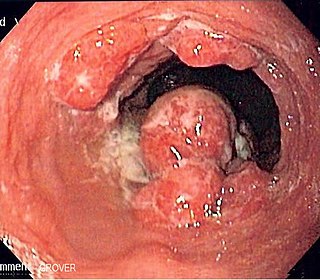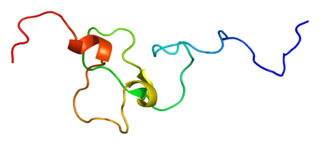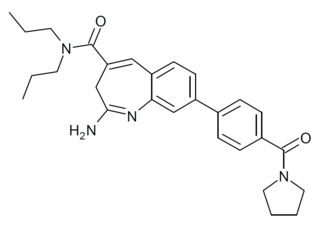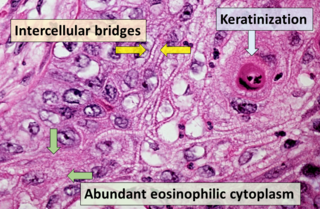
Esophageal cancer is cancer arising from the esophagus—the food pipe that runs between the throat and the stomach. Symptoms often include difficulty in swallowing and weight loss. Other symptoms may include pain when swallowing, a hoarse voice, enlarged lymph nodes ("glands") around the collarbone, a dry cough, and possibly coughing up or vomiting blood.

Cutaneous squamous-cell carcinoma (cSCC), or squamous-cell carcinoma of the skin, also known as squamous-cell skin cancer, is, with basal-cell carcinoma and melanoma, one of the three principal types of skin cancer. cSCC typically presents as a hard lump with a scaly top layer, but it may instead form an ulcer. Onset often occurs over a period of months. Cutaneous squamous-cell carcinoma is more likely to spread to distant areas than basal cell cancer. When confined to the outermost layer of the skin, a pre-invasive, or in situ, form of cSCC is known as Bowen's disease.

Oral cancer, also known as mouth cancer, is a cancer of the lining of the lips, mouth, or upper throat. In the mouth, it most commonly starts as a painless white patch, that thickens, develops red patches, an ulcer, and continues to grow. When on the lips, it commonly looks like a persistent crusting ulcer that does not heal, and slowly grows. Other symptoms may include difficult or painful swallowing, new lumps or bumps in the neck, a swelling in the mouth, or a feeling of numbness in the mouth or lips.

Head and neck cancer develops from tissues in the lip and oral cavity (mouth), larynx (throat), salivary glands, nose, sinuses, or skin of the face. The most common types of head and neck cancer occur in the lips, mouth, and larynx. Symptoms predominantly include a sore that does not heal or a change in the voice. In those with advanced disease, there may be unusual bleeding, facial pain, numbness or swelling, and visible lumps on the outside of the neck or oral cavity. Given the location of these cancers, it is possible for an afflicted individual to experience difficulty in breathing.

Nasopharyngeal carcinoma (NPC), or nasopharynx cancer, is the most common cancer originating in the nasopharynx, most commonly in the postero-lateral nasopharynx or pharyngeal recess, accounting for 50% of cases. NPC occurs in children and adults. NPC differs significantly from other cancers of the head and neck in its occurrence, causes, clinical behavior, and treatment. It is vastly more common in certain regions of East Asia and Africa than elsewhere, with viral, dietary and genetic factors implicated in its causation. It is most common in males. It is a squamous cell carcinoma of an undifferentiated type. Squamous epithelial cells are a flat type of cell found in the skin and the membranes that line some body cavities. Undifferentiated cells are cells that do not have their mature features or functions.

Cyclin D1 is a protein that in humans is encoded by the CCND1 gene.

Peroxiredoxin-1 is a protein that in humans is encoded by the PRDX1 gene.

40S ribosomal protein S27 also known as metallopan-stimulin 1 or MPS-1 is a protein that in humans is encoded by the RPS27 gene. Metallopanstimulin is a zinc finger protein proposed to be involved DNA repair as well as oncogenesis.

Inhibitor of growth protein 4 is a protein that in humans is encoded by the ING4 gene.
Eric M. Genden, MD, MHCA, FACS is a United States head and neck cancer surgeon at the Icahn School of Medicine at Mount Sinai and Mount Sinai Health System in New York City. where he serves as the Isidore Friesner Professor and Chairman of Otolaryngology–Head and Neck Surgery and Professor of Neurosurgery and Immunology. According to his biography at Mount Sinai, Genden's professional titles also include Senior Associate Dean for Clinical Affairs, He is Executive Vice President of Ambulatory Surgery, and Director of the Head and Neck Institute at the Mount Sinai Health System.

Temoporfin (INN) is a photosensitizer used in photodynamic therapy for the treatment of squamous cell carcinoma of the head and neck . It is marketed in the European Union under the brand name Foscan. The U.S. Food and Drug Administration (FDA) declined to approve Foscan in 2000. The EU approved its use in June 2001.

Human papillomavirus-positive oropharyngeal cancer, is a cancer of the throat caused by the human papillomavirus type 16 virus (HPV16). In the past, cancer of the oropharynx (throat) was associated with the use of alcohol or tobacco or both, but the majority of cases are now associated with the HPV virus, acquired by having oral contact with the genitals of a person who has a genital HPV infection. Risk factors include having a large number of sexual partners, a history of oral-genital sex or anal–oral sex, having a female partner with a history of either an abnormal Pap smear or cervical dysplasia, having chronic periodontitis, and, among men, younger age at first intercourse and a history of genital warts. HPV-positive OPC is considered a separate disease from HPV-negative oropharyngeal cancer.

In molecular biology miR-205 microRNA is a short RNA molecule. MicroRNAs function to regulate the expression levels of other genes by several mechanisms. They are involved in numerous cellular processes, including development, proliferation, and apoptosis. Currently, it is believed that miRNAs elicit their effect by silencing the expression of target genes.

Wolfram Samlowski is an American medical oncologist with Comprehensive Cancer Centers of Nevada (CCCN) and a member of the Research Developmental Therapeutics and Genitourinary Committees for US Oncology. His research interests include translational research and development of novel cancer immunotherapy agents, translational drug development as well as gene therapy. His clinical interests are in developing more effective treatments for advanced stages of melanoma and non-melanoma skin cancers, and renal cancer.
In molecular biology mir-497 microRNA is a short RNA molecule. MicroRNAs function to regulate the expression levels of other genes by several mechanisms.
In molecular biology mir-708 microRNA is a short RNA molecule. MicroRNAs function to regulate the expression levels of other genes by several mechanisms. miR-708 is located on chromosome 11q14.1 and is endcoded in intron 1 of the ODZ4 gene. It is most highly expressed in the brain and eyes, and has a supposed role in endoplasmic reticular stress of the eye.
Sandro Porceddu is a head and neck radiation oncologist at Brisbane's Princess Alexandra Hospital and a Professor with the University of Queensland. He was president of the Clinical Oncologic Society of Australia (COSA) and chair of the Trials Scientific Committee of the Trans Tasman Radiation Oncology Group (TROG).

Motolimod (VTX-2337) is a drug which acts as a potent and selective agonist of toll-like receptor 8 (TLR8), a receptor involved in the regulation of the immune system. It is used to stimulate the immune system, and has potential application as an adjuvant therapy in cancer chemotherapy, although clinical trials have shown only modest benefits. It also worsens neuropathic pain in animal models and has been used to research the potential of targeting TLR8 in some kinds of chronic pain syndromes.

Squamous-cell carcinoma (SCC), also known as epidermoid carcinoma, comprises a number of different types of cancer that begin in squamous cells. These cells form on the surface of the skin, on the lining of hollow organs in the body, and on the lining of the respiratory and digestive tracts.
Roy S. Herbst is an American oncologist who is the Ensign Professor of Medicine, Professor of Pharmacology, Chief of Medical Oncology, and Associate Director for Translational Research at Yale Cancer Center and Yale School of Medicine in New Haven, Connecticut.















